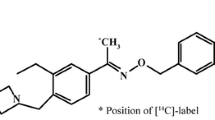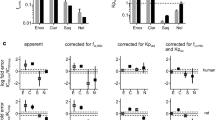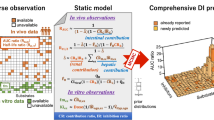Abstract
Purpose. To quantitatively predict the in vivo interaction betweentriazolam and erythromycin, which involves mechanism-basedinhibition of CYP3A4, from in vitro studies using human liver microsomes(HLM) and recombinant human CYP3A4 (REC).
Methods. HLM or REC was preincubated with erythromycin in thepresence of NADPH and then triazolam was added. α- and 4-hydroxy(OH) triazolam were quantified after a 3 min incubation and the kineticparameters for enzyme inactivation (kinact and K′ app) were obtained.Drug-drug interaction in vivo was predicted based on aphysiologically-based pharmacokinetic (PBPK) model, using triazolam anderythromycin pharmacokinetic parameters obtained from the literature and kineticparameters for the enzyme inactivation obtained in the in vitro studies.
Results. Whichever enzyme was used, triazolam metabolism was notinhibited without preincubation, even if the erythromycin concentrationwas increased. The degree of inhibition depended on preincubationtime and erythromycin concentration. The values obtained for kinactand K′ app were 0.062 min−1 and 15.9 μM (α-OH, HLM), 0.055 min−1and 17.4 μM (4-OH, HLM), 0.173 min−1 and 19.1 μM (α-OH, REC),and 0.097 min−1 and 18.9 μM (4-OH, REC). Based on the kineticparameters obtained using HLM and REC, the AUCpo of triazolamwas predicted to increase 2.0- and 2.6-fold, respectively, followingoral administration of erythromycin (333 mg t.i.d. for 3 days), whichagreed well with the reported data.
Conclusions. In vivo interaction between triazolam and erythromycinwas successfully predicted from in vitro data based on a PBPK modelinvolving a mechanism-based inhibition of CYP3A4.
Similar content being viewed by others
REFERENCES
Pharmaceutical Affairs Bureau, Japanese Ministry of Health and Welfare: A report on investigation of side effects of sorivudine: deaths caused by interaction between sorivudine and 5-FU prodrugs (in Japanese). June, 1994.
H. Okuda, T. Nishiyama, K. Ogura, S. Nagayama, K. Ikeda, S. Yamaguchi, Y. Nakamura, Y. Kawaguchi, and T. Watabe. Lethal drug interactions of sorivudine, a new antiviral drug, with oral 5-fluorouracil prodrugs. Drug Metab. Dispos. 25:270–273 (1997).
C. Desgranges, G. Razaka, E. D. Clercq, P. Herdewijn, J. Balzarini, F. Drouillet, and H. Bricaud. Effect of (E)-5-(2-Bromovinyl)uracil on the catabolism and antitumor activity of 5-fluorouracil in rats and leukemic mice. Cancer Res. 46:1094–1101 (1986).
K. Ito, T. Iwatsubo, S. Kanamitsu, K. Ueda, H. Suzuki, and Y. Sugiyama. Prediction of pharmacokinetic alterations caused by drug-drug interactions. Pharmacol. Rev. 50:387–411 (1998).
P. Periti, T. Mazzei, E. Mini, and A. Novelli. Pharmacokinetic drug interactions of macrolides. Clin. Pharmacokinet. 23:106–31 (1992).
J. P. Phillips, E. J. Antal, and R. B. Smith. A pharmacokinetic drug interaction between erythromycin and triazolam. J. Clin. Psychopharmacol. 6:297–299 (1986).
K. Yamaoka, Y. Tanigawara, T. Nakagawa, and T. Uno. A pharmacokinetic analysis program (MULTI) for microcomputer. J. Phar-macobio-Dyn. 4:879–885 (1981).
S. G. Waley. Kinetics of suicide substrates. Practical procedures for determining parameters. Biochem. J. 227:843–849 (1985).
R. B. Silverman. Mechanism-based enzyme inactivation. In Chemistry and Enzymology, Vols. 1 and 2, CRC Press, Boca Raton, FL, 1988, pp. 3–16.
F. S. Eberts Jr., Y. Philopoulos, L. M. Reineke, and R. W. Vliek. Triazolam disposition. Clin. Pharmacol. Ther. 29:81–93 (1981).
MARTINDALE The Extra Pharamcopoeia, Thirty-first edition, the Royal Pharmaceutical Society of Great Britain, London, 1996.
H. Shiraki and F. P. Guengerich. Turnover of membrane proteins: kinetics of induction and degradation of seven forms of rat liver microsomal cytochrome P-450, NADPH-cytochrome P-450 reductase, and epoxide hydrolase. Arch. Biochem. Biophys. 235:86–96 (1984).
T. Iwatsubo, N. Hirota, T. Ooie, H. Suzuki, N. Shimada, K. Chiba, T. Ishizaki, C. E. Green, C. A. Tyson, and Y. Sugiyama. Prediction of in vivo drug metabolism in the human liver from in vitro metabolism data. Pharmacol. Ther. 73:147–171 (1997).
Goodman and Gilman's The pharmacological basis of therapeutics, Ninth edition, J. G. Hardman and L. E. Limbird (eds.), MacGraw-Hill, New York, 1996.
D. J. Birkett, R. A. Robson, N. Grgurinovich and A. Tonkin. Single oral dose pharmacokinetics of erythromycin and roxithromycin and the effects of chronic dosing. Ther. Drug Monit. 12: 65–71 (1990).
T. Kronbach, D. Mathys, M. Umeno, F. J. Gonzalez, and U. A. Meyer. Oxidation of midazolam and triazolam by human liver cytochrome P450IIIA4. Mol. Pharmacol. 36:89–96 (1989).
L. L. von Moltke, D. J. Greenblatt, J. S. Harmatz, S. X. Duan, L. M. Harrel, M. M. Cotreau-Bibbo, G. A. Pritchard, C. E. Wright, and R. I. Shader. Triazolam biotransformation by human liver microsomes in vitro: Effect of metabolic inhibitors and clinical confirmation of a predicted interaction with ketoconazole. J. Pharmacol. Exp. Ther. 276:370–379 (1996).
S. A. Wrighton and B. J. Ring. Inhibition of human CYP3A catalyzed 1'-hydroxy midazolam formation by ketoconaÿzole, nifedipine, erythromycin, cimetidine, and nizatidine. Pharm. Res. 11:921–924 (1994).
K. E. Thummel and G. R. Wilkinson. In vitro and in vivo drug interactions involving human CYP3A. Annu. Rev. Pharmacol. Toxicol. 38:389–460 (1998).
H. Echizen, H. Kawasaki, K. Chiba, M. Tani, and T. Ishizaki. A potent inhibitory effect of erythromycin and other macrolide antibiotics on the mono-N-dealkylation metabolism of disopyramide with human liver microsomes. J. Pharmacol. Exp. Ther. 264:1425–1431 (1993).
M. Murray. Mechanisms of the inhibition of cytochrome P-450-mediated drug oxidation by therapeutic agents. Drug Metab. Rev. 18:55–81 (1987).
K. Ito, T. Iwatsubo, S. Kanamitsu, K. Ueda, H. Suzuki, and Y. Sugiyama. Quantitative prediction of in vivo drug clearance and drug interactions from in vitro data on metabolism, together with binding and transport. Annu. Rev. Pharmacol. Toxicol. 38:461–499 (1998).
S. Kanamitsu, K. Ito, H. Okuda, K. Ogura, T. Watabe, K. Muro, and Y. Sugiyama. Prediction of in vitro drug-drug interactions based on mechanism-based inhibition from in vitro data: Inhibition of 5-fluorouracil metabolism by (E)-5-(2-bromovinyl) uracil. Drug Metab. Dispos. (in press).
J. C. Kolars, W. M. Awni, R. M. Merion, and P. B. Watkins. First-pass metabolism of cyclosporin by the gut. Lancet 338:1488–1490 (1991).
K. E. Thummel, D. O'shea, M. F. Paine, D. D. Shen, K. L. Kunze, J. D. Perkins, and G. R. Wilkinson. Oral first-pass elimination of midazolam involves both gastrointestinal and hepatic CYP3A-mediated metabolism. Clin. Phamracol. Ther. 59:491–502 (1996).
Author information
Authors and Affiliations
Rights and permissions
About this article
Cite this article
Kanamitsu, Si., Ito, K., Green, C.E. et al. Prediction of In Vivo Interaction Between Triazolam and Erythromycin Based on In Vitro Studies Using Human Liver Microsomes and Recombinant Human CYP3A4. Pharm Res 17, 419–426 (2000). https://doi.org/10.1023/A:1007572803027
Issue Date:
DOI: https://doi.org/10.1023/A:1007572803027




